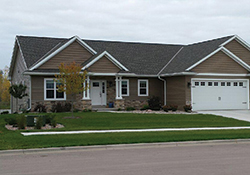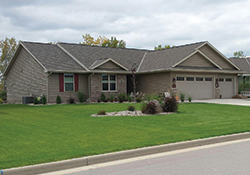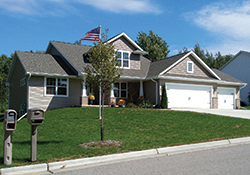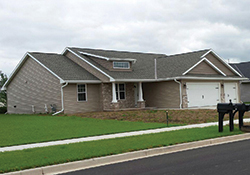This article is the first in the new “REALTORS® Building Great Communities” series dedicated to showcasing the important role many REALTORS® play in helping their communities sustain the prosperity and quality of life we all want for our families, friends, neighbors and clients. If you have a story, please share it with us, and please share this story with friends and family to help them understand how REALTORS® help build great communities.
Flashback
It’s 2010. The Great Recession is in full swing, wreaking havoc on lives and businesses across the globe — and in Brown County, Wisconsin. Washington’s Dodd-Frank financial reforms are coming online, wreaking havoc on banks and their willingness to finance real estate transactions across the country — and in Brown County, Wisconsin. Wisconsin’s cap on increasing property taxes on existing property has local governments worrying about the ability to deliver necessary public services across the state — and in Brown County, Wisconsin.
Fast forward
It’s 2016. More than 230 new homeowners are enjoying life in Brown County communities including De Pere, Howard, Lawrence and Ledgeview. The builders who helped construct the 230 new homes enjoyed the 2011-14 recession and post-recession years more than their peers in many other places. Having worked with local builders and governments to develop a new source of financing, local REALTORS® were able to develop the properties that became the good homes and jobs that made all of the above possible. And local government officials and their constituents have an expanded property tax base that is helping support local services.
How it began
Pat Kaster remembers the day it all began like it was yesterday. She and a number of other REALTORS® and builders had just gotten a dose of reality from their Congressman. “Government has decided that real estate is toxic,” she remembers Democrat Steve Kagen telling them. Toxic real estate plus Dodd-Frank meant no financing for the lots Pat sought to develop, the new homes builders wanted to build, or the affordable housing potential homebuyers needed.
The REALTORS®, builders, bankers, surveyors and others gathered after that and ultimately concluded that they had only two choices. “We could either just take it and do nothing, or we could get proactive,” Pat recalls. “We figured given the stakes, we really only had one choice, and we decided to get proactive, very proactive.”
What they did
REALTORS® and builders tackled these serious economic challenges they were facing and Congressman Kagen’s comments at the next meeting of the Brown County Builders Development Council. The council immediately created a task force, and everyone went to work. “It was a tumultuous time,” remembers Julie Yelle, government affairs/program coordinator for the Brown County Home Builders, who sent requests to 22 townships asking for local officials to meet with task force members to discuss challenges and opportunities. Task force members then met with local government leaders who were grappling with their own financial concerns, and together they began to explore the possibility of local governments bonding for infrastructure improvements at new developments.
The idea was less a break with tradition than it was a revisiting of past practices. Pat and others on the task force remember when communities bonding together for infrastructure improvements in new developments was standard operating procedure. Given that history, it seemed reasonable to suggest to local elected officials that, at a time when it was difficult for developers and homebuyers to get funding from banks, turning to government bonding and/or government access to lower-cost money from banks made sense as a way to reduce the amount of money builders needed from private lenders and ease the path to homeownership.
Not everyone was interested, but local officials in De Pere, Howard, Lawrence and Ledgeview were receptive to the idea. “I don’t think it was a matter of choice,” remembers Howard Village President Burt McIntyre, pointing to the positive benefits of homeownership and local governments’ need to encourage new development as a source of additional property tax revenue. Lawrence Village Administrator Bob Bartelt agreed, pointing out that it made short-term financial sense for the communities as well because “we could get the money cheaper and charge an administrative fee.” And, for their part, members of the task force were happy to work with local officials who were interested in finding ways to make development work rather than trying to figure out how to stop it.
Faithful to their local responsibilities, however, government leaders made it clear that they would be interested in bonding only for developments that met specific criteria and that clearly served the best interests of their individual communities. That meant there would be no “one size fits all” approach; rather each proposed development would be judged on its merits — one of which it was clearly understood would be the reputations of the developers, which was another critical factor underscoring the importance of REALTORS® being visible while working with and earning the respect of their local officials.
Putting all the pieces together took time because of labor shortages and rising prices, but Pat qualified and ultimately completed separate developments in De Pere, Howard, Lawrence and Ledgeview. The terms were different in each of those communities, and local officials and homeowners in each community now attest to the success of the approach.
In October during a meeting in Pat’s River City REALTORS® office in Green Bay, local officials, REALTORS® and builders agreed that a shared understanding of the challenges they faced was key to getting the project done, and they also said that having partners who worked at cooperating and shared a desire to find win-win opportunities made a huge difference.
Pat summed up the general feeling in the room when asked what she thought distinguished Brown County from other places. She responded by pointing at the crowd in her office. “What makes Brown County different?” she asked. “These people make the difference.”
| The city of De Pere did 31 lots in two different phases in one River City REALTORS® development. |
|

|
|
| The village of Howard did 76 lots in three different phases in one River City REALTORS® development. |
|
 |
|
| The town of Lawrence did 76 lots in three different phases in one River City REALTORS® development. |
|
 |
|
| The town of Ledgeview did 48 lots in one River City REALTORS® development. |
|
 |
|
James B. Wood is Chairman of Wood Communications Group based in Madison. He also serves as Strategic Counsel to Competitive Wisconsin Inc., The BE BOLD Council, the Wisconsin Education Business Roundtable and the Wisconsin REALTORS® Foundation and is a long-time consultant and strategic planning facilitator for the WRA.